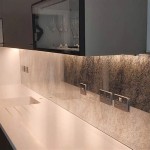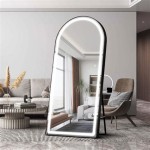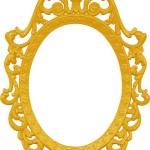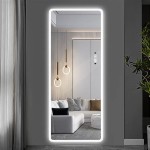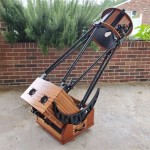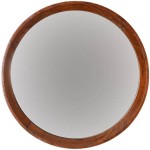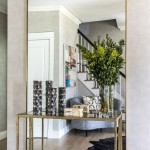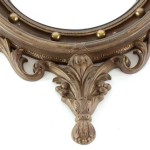Can Any Mirror Be Used Outdoors?
The question of whether any mirror can be used outdoors is not a simple one, demanding a nuanced understanding of mirror construction, environmental factors, and potential hazards. While mirrors may appear to be simple objects, their performance and longevity are significantly affected by the conditions to which they are exposed. Standard indoor mirrors are often ill-suited for outdoor use, leading to degradation, distortion, and even potential safety risks. Understanding why this is the case involves examining the materials and techniques used in their manufacture, as well as the specific environmental challenges they face when placed outdoors.
The primary component of most mirrors is a sheet of glass. This glass is typically float glass, a high-quality sheet glass produced by floating molten glass on a bed of molten metal, usually tin. This process creates a perfectly flat and smooth surface. However, the glass itself is only a substrate. The reflective property of a mirror comes from a metallic coating applied to the back surface of the glass. This metallic coating is typically silver or aluminum, although other metals may also be used in specific applications.
After the metallic coating is applied, it is covered with one or more protective layers. These layers are crucial for preventing corrosion and physical damage to the delicate metallic film. Common protective layers include copper, paint, and sometimes a final layer of varnish. The effectiveness of these protective layers determines the lifespan and suitability of the mirror for different environments.
When a mirror is placed outdoors, it is exposed to a range of environmental stressors that can significantly impact its performance and longevity. These stressors include fluctuations in temperature, exposure to ultraviolet (UV) radiation from sunlight, humidity, precipitation (rain, snow, hail), and potentially abrasive particles carried by the wind (dust, sand). Each of these factors contributes to the degradation of the mirror's components.
Temperature fluctuations can cause the glass to expand and contract. While glass is generally resilient, repeated expansion and contraction cycles can lead to stress fractures, especially if the mirror is not properly mounted or if the glass has inherent imperfections. More critically, temperature changes can affect the adhesion of the metallic coating and protective layers to the glass. Differences in thermal expansion coefficients between the glass and the metallic layers can cause the layers to separate or delaminate over time, resulting in black spots, clouding, and a loss of reflectivity.
UV radiation is another significant factor in the degradation of outdoor mirrors. UV light can penetrate the protective layers and cause chemical reactions in the metallic coating, leading to oxidation and corrosion. This is particularly problematic for silver coatings, which are highly susceptible to oxidation. Over time, UV exposure can cause the metallic layer to become dull and less reflective, diminishing the mirror's overall performance. The protective paints and varnishes themselves can also degrade under UV exposure, becoming brittle and prone to cracking, which further exposes the metallic layer to the elements.
Humidity is a constant threat to the integrity of a mirror's backing. Moisture can seep through even seemingly impermeable protective layers, reaching the metallic coating. This moisture can then react with the metal, causing corrosion and the formation of unsightly spots and blemishes. In areas with high humidity, this process can be accelerated, leading to rapid deterioration of the mirror. Condensation forming on the back of the mirror due to temperature differences can also contribute to this problem.
Precipitation, in the form of rain, snow, and hail, can exacerbate the effects of humidity and temperature fluctuations. Rainwater can contain dissolved acids or pollutants that can corrode the protective layers and metallic coating. Snow and ice can exert pressure on the mirror, potentially causing stress fractures or delamination. Hail can cause direct physical damage to the glass and protective layers.
Windborne particles, such as dust and sand, can also contribute to the wear and tear of outdoor mirrors. These particles can act as abrasives, scratching the surface of the glass and wearing away the protective layers. In areas with strong winds and sandy soil, this abrasion can be particularly severe, leading to a loss of clarity and reflectivity.
Understanding Mirror Construction and its Limits
The typical construction of an indoor mirror, with its relatively thin protective layers, makes it unsuitable for prolonged outdoor use. Indoor mirrors are designed to withstand the relatively stable environmental conditions of a controlled indoor environment. They are not engineered to resist the harsh conditions of outdoor exposure. Using an indoor mirror outdoors will likely result in premature failure and a significant reduction in its lifespan.
The type of glass used also plays a role. Standard float glass, while suitable for many indoor applications, can be susceptible to thermal stress cracking outdoors. Some mirrors use tempered glass, which is significantly stronger and more resistant to thermal shock. Tempered glass is created through a process of controlled heating and cooling, which increases its strength and makes it less likely to shatter. While tempered glass offers improved durability, it does not necessarily protect the metallic coating from corrosion and UV degradation.
The quality and type of metallic coating are also critical. Silver coatings, while highly reflective, are particularly vulnerable to oxidation and corrosion. Aluminum coatings are more resistant to corrosion but may not provide the same level of reflectivity. The thickness and uniformity of the metallic coating can also affect its durability. Thicker, more uniform coatings are generally more resistant to degradation.
Specific Concerns Regarding Safety
Beyond the aesthetic and functional degradation of the mirror, there are also safety concerns associated with using standard mirrors outdoors. As the mirror deteriorates, the protective layers can peel or flake off, exposing the sharp edges of the glass and potentially creating a hazard. In severe cases, the mirror can crack or shatter, posing a risk of injury from flying shards of glass. This is particularly concerning in areas where children or animals may be present.
Another safety concern arises from the potential for distorted reflections. As the mirror warps or delaminates, the reflected image can become distorted, which can be disorienting or even dangerous, especially in areas with vehicular or pedestrian traffic. A distorted reflection can mislead individuals about distances and directions, potentially leading to accidents.
Furthermore, the use of mirrored surfaces outdoors can create unexpected and potentially hazardous glare. Sunlight reflecting off a mirror can be blinding, creating a temporary loss of vision for individuals in the path of the reflected light. This glare can be particularly dangerous for drivers, cyclists, and pedestrians, increasing the risk of accidents.
Alternatives and Mitigation Strategies
While standard indoor mirrors are generally not suitable for outdoor use, there are alternative materials and construction techniques that can make mirrors more durable and weather-resistant. One option is to use acrylic mirrors, which are made from polymethyl methacrylate (PMMA). Acrylic mirrors are lighter and more impact-resistant than glass mirrors, and they are less likely to shatter. However, acrylic mirrors are also more susceptible to scratching and may not provide the same level of optical clarity as glass mirrors.
Another option is to use specialized outdoor mirrors that are specifically designed and manufactured to withstand the elements. These mirrors typically use thicker glass, more durable metallic coatings, and enhanced protective layers. The protective layers may include UV-resistant coatings and waterproof sealants. These specialized mirrors are often more expensive than standard indoor mirrors, but they offer significantly improved performance and longevity in outdoor environments.
When installing any mirror outdoors, it is important to use appropriate mounting hardware and techniques. The mounting hardware should be made of corrosion-resistant materials, such as stainless steel or aluminum. The mirror should be securely mounted to a stable surface, and the mounting system should allow for some degree of movement to accommodate thermal expansion and contraction. It is also important to ensure that the mirror is properly sealed to prevent moisture from seeping behind it.
Even with specialized outdoor mirrors and proper installation techniques, it is important to regularly inspect and maintain the mirror. This includes cleaning the surface of the mirror to remove dirt and debris, and checking for any signs of damage or deterioration. If any damage is detected, it should be repaired promptly to prevent further degradation. Regular maintenance can significantly extend the lifespan of an outdoor mirror and ensure its continued performance and safety.
Consideration should also be given to the placement of the mirror. Avoid placing the mirror in direct sunlight, where it will be exposed to high levels of UV radiation. Choose a location that is sheltered from the wind and rain, if possible. If the mirror is placed near trees or shrubs, be sure to trim the vegetation regularly to prevent it from scratching the surface of the mirror.

Can Indoor Mirrors Be Used Outside Read This First Decorbaron Com

Reflectr 600mm Outdoor Convex Security Mirror Allsafes Ie

High Low Mirrors In The Garden Gardenista

Reflectr 450mm Outdoor Convex Security Mirror Allsafes Ie

How To Weatherproof A Garden Mirror Hometalk

Toscana Arched Copper Distressed Outdoor Garden Wall Mirror Indoor Or Outside 760mm X 500mm

Outdoor Convex Mirrors Safety For

Convex Mirror Traffic Safety Work Zone Eastsea Rubber

Convex Driving Safety Mirrors For Blind Corners Great American Property

Garden Mirror Acrylic Outdoor Plastic Safety Circle Round Shape
